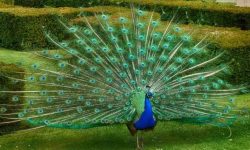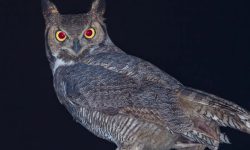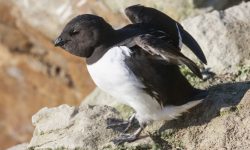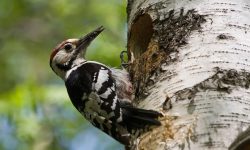Birds flying into windows is one of the most common and puzzling wildlife incidents people experience around homes and buildings. The sudden thud of a bird hitting glass can be alarming and often leaves homeowners wondering why such collisions happen so frequently. Although it may appear accidental or random, this behavior has clear explanations rooted in biology, perception, and environmental conditions.
Understanding why birds collide with windows requires looking at how they see the world. Birds experience light differently from humans. They rely on visual cues that glass simply does not provide. The reflections on windows, the transparency of glass, and the angle of sunlight all influence how a bird interprets the space around it. When these cues become misleading, birds make split-second decisions that lead to collisions.
This article explores the true reasons behind window strikes. It explains how birds perceive reflections, how territory and behavior influence collisions, and why modern buildings unintentionally create deadly barriers. By looking deeper into the science behind this behavior, we can better understand how to reduce collisions and protect the birds that share our environment.
How Birds See the World
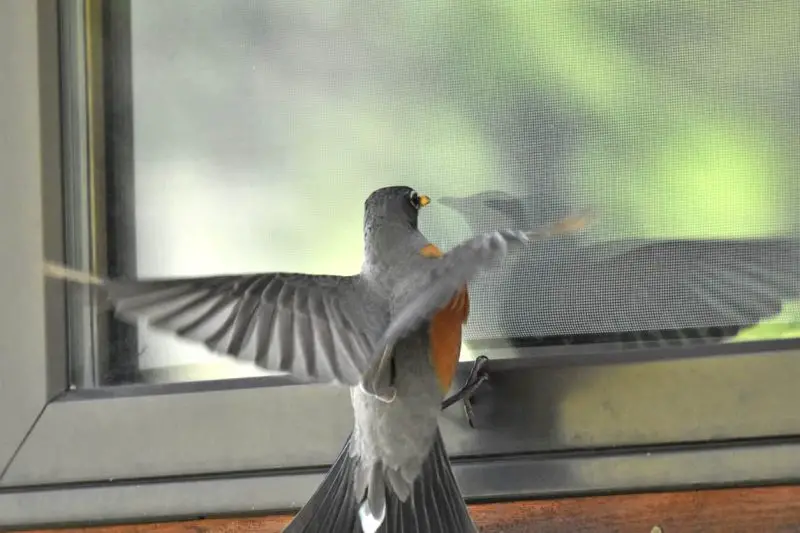
Visual perception and the limits of understanding glass
Birds have exceptional vision. Many species see ultraviolet light, detect rapid motion, and observe details at distances far greater than humans can. Despite this impressive visual system, glass remains outside their natural evolutionary experience. In the wild, transparent obstacles do not exist. Birds identify objects based on patterns, texture, and depth. Glass lacks all three, creating a visual illusion.
When a bird approaches a window, it does not see a barrier. Instead, it interprets the reflected sky or vegetation as open space. This leads to direct flight toward what appears to be a natural environment. Even frosted or lightly tinted windows can remain deceptive if reflections are strong enough. Birds simply do not recognize glass as a physical object until it is too late.
This misunderstanding becomes especially dangerous during high-speed flight. Many bird species rely on momentum and quick navigation through branches and open spaces. Their instincts tell them to trust visual cues, but glass interrupts their path in ways their brains are not equipped to process.
Reflections create a false habitat
One of the strongest forces behind window collisions is reflection. During the day, sunlight hits the surface of the glass and creates a mirror image of whatever landscape lies in front of it. Trees, shrubs, sky, and clouds appear perfectly real to a bird. In some cases, the reflected world looks even more vibrant than the surrounding environment because the glass intensifies light.
Birds often fly directly toward these reflections when escaping predators, searching for food, or moving between perches. Their flight paths are instinctual and urgent, leaving little time to detect subtle distortions. Because reflections look real from a distance, birds accelerate into the glass without hesitation.
The problem becomes more pronounced near large sliding doors, modern buildings with reflective facades, and houses surrounded by foliage. The more natural the reflection appears, the more likely birds are to strike.
Transparency confuses birds during close flight
In addition to reflections, transparent windows also cause confusion. Birds sometimes see through a window to plants, daylight, or indoor greenery and interpret the view as a continuation of outdoor space. This happens frequently in structures with glass corners, screened porches, or opposite windows that create a tunnel of visible light.
For example, a bird may notice a tree on the opposite side of a house. If the window is clear, the bird believes it can fly straight through to reach it. In reality, the glass stands as an invisible barrier. Without evolutionary experience to warn them, birds cannot interpret the transparency correctly.
Clear balcony railings, bus shelters, and office buildings with atriums all present similar challenges. Birds do not understand that transparent objects block their path.
Why Birds Collide During Migration
Nighttime flight and artificial lighting
Migration season is one of the peak times for window collisions. Many bird species migrate at night to avoid predators, conserve energy, and navigate using stars. Artificial lighting from cities disrupts this natural behavior. Lights from buildings, street lamps, and illuminated signs attract or disorient migrating birds. As they approach lit areas, their flight patterns become erratic.
Once a bird nears a brightly lit building, it often circles or becomes trapped in the glow. This spiraling flight increases the chance of hitting windows. Light can also confuse their internal navigation, causing birds to descend toward urban landscapes where reflections and transparent glass are more abundant.
These nighttime collisions are especially common during spring and fall migration, when millions of birds pass through cities and suburban areas. In dense urban centers, entire flocks may become disoriented, leading to mass collision events that occur within just a few days.
Weather conditions amplify confusion
Fog, rain, snow, and low cloud cover can make migration more difficult. Birds rely heavily on celestial cues, but weather obscures stars and moonlight. When visibility decreases, birds descend to lower altitudes where artificial lights and structures become more prominent.
During poor weather, birds may attempt to land or rest near buildings. The increased proximity to reflective windows intensifies collision risks. Even waterfalls of migrating warblers and thrushes can become trapped near illuminated skyscrapers during storms. The combination of low visibility and light pollution has become one of the most significant contributors to large-scale window strikes across major migration flyways.
Exhaustion and rapid movement
Migrating birds travel enormous distances, often flying nonstop for many hours or days. Exhaustion reduces reaction speed and makes birds more susceptible to mistakes. A tired bird may fail to detect a window reflection until the moment of impact. High-speed flight during long journeys also means collisions occur with greater force.
In this weakened state, birds are more vulnerable to illusions created by glass. Even small windows or modest reflections can appear convincingly real to a migrating bird unfamiliar with the landscape.
Territorial Behavior and Window Attacks
Birds attacking their own reflection
Not all window collisions happen in flight. Sometimes birds repeatedly strike their beaks against glass in short bursts. This behavior is often seen in territorial species such as robins, cardinals, wrens, and bluebirds. The bird sees its reflection in the window and believes it is a rival intruder.
Territorial defense is intense during breeding season. Male birds attempt to chase away competitors, but the reflected bird mimics every move. This creates an endless loop of aggression. The bird may attack the window repeatedly, exhausting itself and increasing the risk of injury.
Window attacks during breeding season can continue for hours or days. The behavior usually stops once hormonal changes occur or nesting activities taper off, but the stress remains considerable for the bird involved.
Hormonal triggers during nesting periods
Bird hormones surge in spring as nesting season begins. Testosterone levels rise in males, making them more aggressive and reactive. Even subtle reflections during this period can provoke defensive behavior. Birds perceive the reflection as a threat to their mate, territory, or nest, driving them to confront the “intruder.”
Some surfaces reflect more strongly at certain angles or times of day. Morning sunlight or evening shadows can change reflection patterns and trigger intense reactions from territorial birds.
Not all collisions are accidental
Although many window strikes occur during flight, reflection-based attacks represent another type of collision. These repeated pecking or wing-beating incidents do not always result in severe injury, but they cause stress, energy loss, and potential long-term harm.
Understanding these territorial behaviors helps explain why window collisions increase during certain parts of the year even when migratory activity is low.
Modern Architecture and Collision Risks
Glass buildings and urban environments
Modern architecture relies heavily on glass. While visually appealing, large reflective facades create perfect illusions of open habitat. Birds approaching these structures see sky, trees, or water reflected on the surface and mistake them for natural spaces.
Urban environments also concentrate artificial lighting, which attracts migrating birds. Tall buildings act as magnets for nighttime flyers. Once trapped in urban cores, birds are surrounded by glass walls that increase the chance of fatal collisions.
The scale of glass in modern cities amplifies the problem. A single building with reflective windows can cause hundreds or thousands of strikes during peak migration seasons. Even suburban homes with patio doors or decorative windows contribute to the overall issue.
Indoor plants and bright interiors
Interior lighting plays a significant role in attracting birds toward windows. A bright room filled with plants, sunlight, or visible décor creates the illusion of accessible space. Birds see these objects and attempt to reach them through the glass.
Indoor plants are especially misleading. They appear as natural cover or feeding grounds. Glass walkways, greenhouses, and indoor gardens also create hazardous environments for birds unfamiliar with transparent barriers.
At night, illuminated buildings become even more dangerous. Light shining outward hides reflections and creates a clear path toward a seemingly open area. When birds attempt to fly into these lit spaces, collisions become nearly unavoidable.
Human design choices unintentionally harm wildlife
Most window collision risks arise from unintentional design choices. Homes positioned near wooded areas, gardens, or water increase the likelihood of birds approaching windows naturally. Even small décor choices, such as placing feeders close to windows, can draw birds toward dangerous areas.
Although modern design prioritizes natural light and open views, these features can have unintended consequences. The more inviting the environment appears to humans, the more confusing it may appear to birds. Awareness of how design affects wildlife is essential for reducing impacts.
Seasonal Patterns of Bird-Window Collisions
Spring migration brings increased collisions
During spring migration, birds travel north toward breeding grounds. This period brings large numbers of birds through unfamiliar landscapes. Juvenile birds, inexperienced in migration routes, also join these flights and are especially vulnerable to window strikes.
Spring collisions peak when migratory paths intersect urban centers. As birds arrive tired from long flights, their response time diminishes, and reflections become harder to distinguish. Many species also migrate during early morning hours when reflections are strongest.
Fall migration and inexperienced juveniles
Autumn brings even higher collision numbers. Young birds making their first migration often rely on instinct rather than learned behavior. They cannot recognize reflections or hazards in the same way adult birds do. Their lack of experience increases mistakes during flight.
In fall, vegetation becomes more colorful. Reflections appear richer and more visually deceptive. Birds attracted to the vivid colors of changing leaves may misinterpret window reflections as genuine habitat.
The combination of inexperienced birds, long migration routes, and visually complex landscapes creates ideal conditions for collisions.
Winter collisions, though less common
During winter, some species remain near human habitation. Birds such as cardinals, sparrows, and finches may collide with windows while foraging or escaping predators. Snow and ice amplify reflection intensity, making windows appear brighter and more misleading.
Although winter collisions are fewer than those during migration, they still pose a threat, especially around feeders or near evergreen vegetation.
The Role of Predator Evasion in Window Strikes
Split-second escape decisions
Birds often collide with windows when fleeing predators such as hawks, falcons, or domestic cats. During these rapid escapes, birds focus entirely on evasion. Their brains prioritize speed over careful observation. In these desperate moments, windows become dangerous obstacles.
Because birds rely on instinctual flight paths to escape, they may fly toward reflective areas that appear like dense cover. A reflection of trees or sky looks like a safe escape route. The bird, under extreme stress, does not have time to analyze the scene carefully.
Sudden bursts of flight increase impact force
When birds fly at high speed during predator chases, collisions become far more dangerous. The force of impact increases significantly. Even if a bird survives the collision, internal injuries may occur. These delayed injuries can still be fatal days later.
Predator-driven strikes are more common around homes with large outdoor spaces, gardens, or wooded backyards where hawks frequently hunt.
Domestic cats amplify collision risks
Outdoor cats create constant pressure on local bird populations. Birds chased by cats often panic and make poorly calculated escape attempts. Cats lurking under feeders or shrubs cause birds to flee in unpredictable directions. When a window lies nearby, the chances of collision increase dramatically.
This type of collision is part of a larger issue involving predation and habitat overlap with urban wildlife.
FAQs About Why Birds Fly Into Windows
Why do birds hit windows more in the morning?
Morning sunlight creates strong reflections on glass, making windows look like open sky or vegetation.
Do birds understand that glass is solid?
No. Birds have no evolutionary experience with transparent barriers and cannot interpret glass as a solid object.
Why do cardinals and robins attack windows?
They see their own reflection and interpret it as a rival invading their territory, especially during breeding season.
Do birds survive window collisions?
Some do, but many suffer internal or delayed injuries. Even birds that fly away may not fully recover.
Why do more birds collide during migration?
Migrating birds are tired, disoriented by artificial light, and unfamiliar with the terrain, increasing collision risks.
Does weather affect window strikes?
Yes. Fog, rain, and storms push birds closer to buildings and reduce their ability to navigate safely.
Why do birds hit windows repeatedly?
Territorial birds may continuously attack their reflection, believing it is another bird intruding.
Are tall buildings the biggest problem?
They contribute greatly during migration, but homes with large windows also cause significant yearly collisions.
Why do birds hit windows on cloudy days?
Diffuse light can eliminate shadows and make windows appear even more transparent or reflective.
Do feeders increase window collisions?
Feeders placed too close to windows or in reflective areas can attract birds toward dangerous flight paths.
Final Thoughts
Birds fly into windows because their visual perception cannot interpret reflections, transparency, or artificial lighting. What looks like a barrier to humans appears as open space to a bird. Reflected trees, bright indoor plants, and transparent surfaces create illusions that birds are instinctively drawn toward. Migration, territory defense, predator evasion, and modern architecture all amplify this confusion.
Understanding why collisions happen gives us the opportunity to reduce risks. Simple awareness helps people adjust landscapes and building features to create safer environments for birds. Every window strike is preventable with knowledge and thoughtful design. By recognizing how birds see the world, we gain insight into the challenges they face and the small steps we can take to protect them.
Birds share our homes, cities, and skies. Their collisions with windows remind us how human structures impact wildlife in invisible ways. With greater understanding comes greater responsibility to create spaces where birds can thrive safely and freely.

